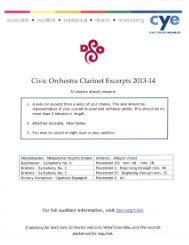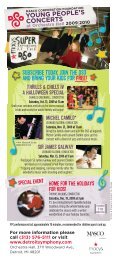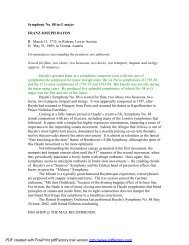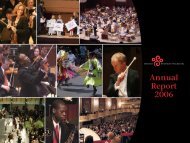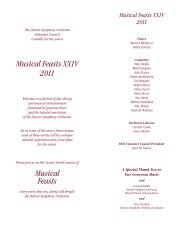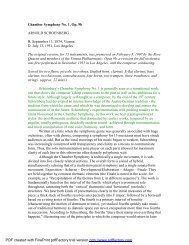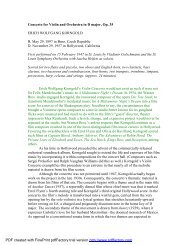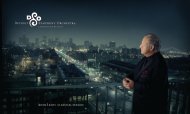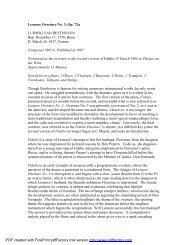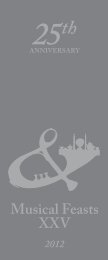Piano Concerto No. 2 - Detroit Symphony Orchestra
Piano Concerto No. 2 - Detroit Symphony Orchestra
Piano Concerto No. 2 - Detroit Symphony Orchestra
You also want an ePaper? Increase the reach of your titles
YUMPU automatically turns print PDFs into web optimized ePapers that Google loves.
SERGEI RACHMANINOFFB. April 1, 1873, Oneg, RussiaD. March 28, 1943, Beverly Hills, CaliforniaFirst performed on <strong>No</strong>vember 9, 1901 in Moscow by Alexander Siloti and the MoscowPhilharmonic Society <strong>Orchestra</strong> with the composer as soloist.Scored for piano soloist, two flutes, two oboes, two clarinets, two bassoons, four horns,two trumpets, three trombones, tuba, bass drum, cymbal and strings (approx. 32minutes).The premiere of the Second <strong>Piano</strong> <strong>Concerto</strong> in 1901 marked the most importantturning point in Sergei Rachmaninoff’s lengthy career. In the preceding years, he had allbut given up on composition. After graduating from the Moscow Conservatory withhighest honors and receiving significant praise for his works from the great Tchaikovskyhimself, he was unprepared for the harsh criticism that followed the dismal 1897premiere of his first symphony. Ridiculed by critics, Rachmaninoff took the news badly.In his memoirs he recalled, “A paralyzing apathy possessed me. I did nothing at all….Half my days were spent lying on a couch and sighing over my ruined life.”For the next several years, Rachmaninoff avoided composition, pouring hisenergy instead into conducting and performing as a pianist. By 1899, however, histemperament had improved. Rachmaninoff’s emotional recovery has been attributed tovarious factors including a successful, confidence-boosting performance in London, hisfirst major foreign appearance; a meeting with the author Lev Tolstoy who, supposedly,encouraged him to drop the self-pity and resume composing; and two sessions with Dr.Nikolay Dahl, a psychologist and amateur musician renowned for his hypnosis therapy,though it remains unclear whether the composer actually underwent such treatment.Rachmaninoff began composing seriously again in 1900, and his first majorproject was the <strong>Piano</strong> <strong>Concerto</strong> <strong>No</strong>. 2. In December, he performed the second and thirdmovements at a concert in Moscow, and the warm reception provided him with themotivation he needed to finish the piece. The concerto was finally premiered in its fullform at a Moscow Philharmonic Society concert in early <strong>No</strong>vember of 1901. Once again,the work was well received, restoring Rachmaninoff’s confidence as a composer andleading him to embark on new works.Since the premiere, <strong>Piano</strong> <strong>Concerto</strong> <strong>No</strong>. 2 has remained one of Rachmaninoff’smost popular compositions and has even been featured prominently in numerous films,including Grand Hotel (1932) and Brief Encounter (1946) in which the concerto servesas the score for the entire film. In Rhapsody (1954), the concerto’s exquisite themes andsumptuous orchestration bring the heroine, played by Elizabeth Taylor, to tears andinspire her to return to the husband she has just deserted. While such melodrama isperhaps extreme, it colorfully portrays the profound emotional power that audiences haveexperienced through Rachmaninoff’s beloved concerto over the past century.The <strong>Detroit</strong> <strong>Symphony</strong> <strong>Orchestra</strong> first performed Rachmaninoff’s <strong>Piano</strong> <strong>Concerto</strong><strong>No</strong>. 2 on April 22, 1921 with Ossip Gabrilowitsch conducting. The DSO last performedthe piece on Oct, 23, 2005 with Jerzy Semkow conducting and André Watts as soloist.PDF created with FinePrint pdfFactory trial version http://www.pdffactory.com
DSO SHOP @ THE MAX RECOMMENDS:Rachmaninoff, <strong>Piano</strong> <strong>Concerto</strong> <strong>No</strong>. 2, Lang Lang, piano, Valery Gergiev conducting theMariinsky (Kirov) Theater <strong>Orchestra</strong>, Deutsche Grammophon B0003902.PDF created with FinePrint pdfFactory trial version http://www.pdffactory.com
Pictures at an ExhibitionMODEST MUSSORGSKYB. March 21, 1839, Karevo, RussiaD. March 28, 1881, St. Petersburg, RussiaVLADIMIR ASHKENAZYB. July 6,1937 in Nizhniy <strong>No</strong>vogorod, RussiaVladimir Ashkenazy’s orchestration of Pictures at an Exhibition was first performed onSeptember 29, 1982 at the Royal Festival Hall, London by Ashkenazy and thePhilharmonia <strong>Orchestra</strong>.Scored for three flutes, two doubling on piccolo, three oboes, one doubling on oboed’amore, two clarinets, E-flat clarinet, bass clarinet, two bassoons, contrabassoon, fourhorns, three trumpets, three trombones, tuba, bass drum, cymbals, glockenspiel, highbells, snare drum, tam tam, triangle, xylophone, two harps, celeste and strings (approx.29 minutes).Modest Mussorgsky composed Pictures at an Exhibition for solo piano in 1874 asa tribute to his recently deceased friend, the artist Viktor Hartmann. Rendered in thecomposer’s characteristically idiosyncratic style, the colorful musical depictions ofHartmann’s artwork prompted Mikhail Tushmalov to orchestrate individual movementsfrom the work in 1886. Over the next century and a quarter, many orchestrators andarrangers would follow Tushmalov’s example. Pictures has been orchestratedapproximately 30 different times, notwithstanding various non-orchestral renditions thatrange from Emerson, Lake & Palmer’s rock version to an arrangement for accordion trio.Maurice Ravel’s 1922 orchestration is the most familiar concert version, and itspopularity with audiences overshadows even that of Mussorgsky’s original work forpiano. Consequently, subsequent arrangers have had to confront not only Mussorgsky’soriginal but also Ravel’s celebrated rendering. Vladimir Ashkenazy’s orchestration ofPictures is no exception, and Ashkenazy’s extensive experience as both a pianist and aconductor makes him particularly well-suited to the task.As Ashkenazy explained to the writer Jasper Parrott, “I admire Ravel’sorchestration tremendously and think that it is a fantastic piece of work. But I think that ithas very little of Mussorgsky in it. One only needs to listen to Boris Godunov inMussorgsky’s original orchestration to see what I mean. Mussorgsky wasn’t interestedeither in brilliance for its own sake or in a lot of light colors; he wanted deep, heavy,muddy colors, and that is what I think Ravel did not want to understand.” In addition tomolding the instrumentation to reflect Mussorgsky’s own approach to orchestration,Ashkenazy also based his work on the composer’s original manuscript, thereby fixing theerrata that Ravel had unwittingly inherited from the unfaithful piano edition he used ashis source.PDF created with FinePrint pdfFactory trial version http://www.pdffactory.com
Ravel’s version begins with a lone trumpet; Ashkenazy’s opens with three. It is asubtle adjustment, but the full sound of the entire trumpet section catches the earimmediately. The rest of the opening promenade follows in a similarly weighty stylewith rich, full tutti passages showcasing the depth and breadth of the orchestra’s soniccapacity. Ironically, the measures in which Ravel added more orchestral heft are the veryones that Ashkenazy scales back, using the bright timbres of the woodwind section toprovide greater contrast and textural transparency. In later movements, too, Ashkenazy’schoices reflect a deep respect for both Ravel’s version and Mussorgsky’s distinct musicalvoice. Instead of breaking radically from Ravel’s model, Ashkenazy makes cleveralterations that darken and saturate the orchestral palette without diminishing any ofRavel’s bold juxtapositions of instrumental color. In place of Ravel’s solo saxophone inIl vecchio castello, Ashkenazy uses the dusky-toned oboe d’amore; instead of Ravel’sdistant and gentle tenor tuba solo in Bydlo, Ashkenazy unleashes four French horns thatbellow the theme lustily. In addition to these and other changes, Ashkenazy also restoresa promenade passage between Two Polish Jews and Limoges that Ravel omitted fromMussorgsky’s original. In the famous Great Gate of Kiev, Ashkenazy introduces otherwelcome surprises and somehow manages to end the work with an even more powerfulorchestral climax than Ravel had achieved. Throughout the work, however, Ashkenazy’smusical intentions remain simple and direct. As he put it, “If I have revealed a little moreof Mussorgsky, I shall be happy. That is all I was aiming at.”This is the <strong>Detroit</strong> <strong>Symphony</strong> <strong>Orchestra</strong>’s premiere of Ashkenazy’s arrangementof Mussorgsky’s Pictures at an Exhibition. The DSO first performed the Ravel’s versionon <strong>No</strong>v. 30, 1972, with Paul Kletzki conducting and last performed it on <strong>No</strong>v. 5, 2005,with Resident Conductor Thomas Wilkins conducting.DSO SHOP @ THE MAX RECOMMENDS:Mussorgsky, Pictures at an Exhibition, Vladimir Ashkenazy conducting the NewPhilharmonia <strong>Orchestra</strong> of London, Decca B0007973.Program notes by Nathan Platte, a doctoral candidate in musicology at the University ofMichigan School of Music, Theatre & Dance.PDF created with FinePrint pdfFactory trial version http://www.pdffactory.com
Pictures at an ExhibitionMODEST MUSSORGSKYB. March 21, 1839, Karevo, RussiaD. March 28, 1881, St. Petersburg, RussiaVLADIMIR ASHKENAZYB. July 6,1937 in Nizhniy <strong>No</strong>vogorod, RussiaVladimir Ashkenazy’s orchestration of Pictures at an Exhibition was first performed onSeptember 29, 1982 at the Royal Festival Hall, London by Ashkenazy and thePhilharmonia <strong>Orchestra</strong>.Scored for three flutes, two doubling on piccolo, three oboes, one doubling on oboed’amore, two clarinets, E-flat clarinet, bass clarinet, two bassoons, contrabassoon, fourhorns, three trumpets, three trombones, tuba, bass drum, cymbals, glockenspiel, highbells, snare drum, tam tam, triangle, xylophone, two harps, celeste and strings (approx.29 minutes).Modest Mussorgsky composed Pictures at an Exhibition for solo piano in 1874 asa tribute to his recently deceased friend, the artist Viktor Hartmann. Rendered in thecomposer’s characteristically idiosyncratic style, the colorful musical depictions ofHartmann’s artwork prompted Mikhail Tushmalov to orchestrate individual movementsfrom the work in 1886. Over the next century and a quarter, many orchestrators andarrangers would follow Tushmalov’s example. Pictures has been orchestratedapproximately 30 different times, notwithstanding various non-orchestral renditions thatrange from Emerson, Lake & Palmer’s rock version to an arrangement for accordion trio.Maurice Ravel’s 1922 orchestration is the most familiar concert version, and itspopularity with audiences overshadows even that of Mussorgsky’s original work forpiano. Consequently, subsequent arrangers have had to confront not only Mussorgsky’soriginal but also Ravel’s celebrated rendering. Vladimir Ashkenazy’s orchestration ofPictures is no exception, and Ashkenazy’s extensive experience as both a pianist and aconductor makes him particularly well-suited to the task.As Ashkenazy explained to the writer Jasper Parrott, “I admire Ravel’sorchestration tremendously and think that it is a fantastic piece of work. But I think that ithas very little of Mussorgsky in it. One only needs to listen to Boris Godunov inMussorgsky’s original orchestration to see what I mean. Mussorgsky wasn’t interestedeither in brilliance for its own sake or in a lot of light colors; he wanted deep, heavy,muddy colors, and that is what I think Ravel did not want to understand.” In addition tomolding the instrumentation to reflect Mussorgsky’s own approach to orchestration,Ashkenazy also based his work on the composer’s original manuscript, thereby fixing theerrata that Ravel had unwittingly inherited from the unfaithful piano edition he used ashis source.PDF created with FinePrint pdfFactory trial version http://www.pdffactory.com
Ravel’s version begins with a lone trumpet; Ashkenazy’s opens with three. It is asubtle adjustment, but the full sound of the entire trumpet section catches the earimmediately. The rest of the opening promenade follows in a similarly weighty stylewith rich, full tutti passages showcasing the depth and breadth of the orchestra’s soniccapacity. Ironically, the measures in which Ravel added more orchestral heft are the veryones that Ashkenazy scales back, using the bright timbres of the woodwind section toprovide greater contrast and textural transparency. In later movements, too, Ashkenazy’schoices reflect a deep respect for both Ravel’s version and Mussorgsky’s distinct musicalvoice. Instead of breaking radically from Ravel’s model, Ashkenazy makes cleveralterations that darken and saturate the orchestral palette without diminishing any ofRavel’s bold juxtapositions of instrumental color. In place of Ravel’s solo saxophone inIl vecchio castello, Ashkenazy uses the dusky-toned oboe d’amore; instead of Ravel’sdistant and gentle tenor tuba solo in Bydlo, Ashkenazy unleashes four French horns thatbellow the theme lustily. In addition to these and other changes, Ashkenazy also restoresa promenade passage between Two Polish Jews and Limoges that Ravel omitted fromMussorgsky’s original. In the famous Great Gate of Kiev, Ashkenazy introduces otherwelcome surprises and somehow manages to end the work with an even more powerfulorchestral climax than Ravel had achieved. Throughout the work, however, Ashkenazy’smusical intentions remain simple and direct. As he put it, “If I have revealed a little moreof Mussorgsky, I shall be happy. That is all I was aiming at.”This is the <strong>Detroit</strong> <strong>Symphony</strong> <strong>Orchestra</strong>’s premiere of Ashkenazy’s arrangementof Mussorgsky’s Pictures at an Exhibition. The DSO first performed the Ravel’s versionon <strong>No</strong>v. 30, 1972, with Paul Kletzki conducting and last performed it on <strong>No</strong>v. 5, 2005,with Resident Conductor Thomas Wilkins conducting.DSO SHOP @ THE MAX RECOMMENDS:Mussorgsky, Pictures at an Exhibition, Vladimir Ashkenazy conducting the NewPhilharmonia <strong>Orchestra</strong> of London, Decca B0007973.Program notes by Nathan Platte, a doctoral candidate in musicology at the University ofMichigan School of Music, Theatre & Dance.PDF created with FinePrint pdfFactory trial version http://www.pdffactory.com



